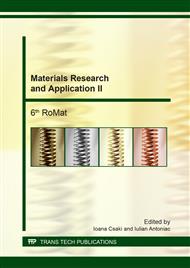[1]
Sadki, M.L. Hattali, M. A. Bradai, R. Youne, N. Mesrati, Characterization and Modeling of the Mechanical Behavior of Aeronautical Alloy Based Composite, Universal Journal of Chemistry 4(1) (2016) 10-19.
DOI: 10.13189/ujc.2016.040102
Google Scholar
[2]
P. Rambabu, N Eswara Prasad et all, Aluminium Alloy for Aerospace Application in: Prasad N.E. and Wanhill R.J.H. (Eds. ), Aerospace Materials and Material Technologies, Springer Science, Singapore, (2017), 29-52.
DOI: 10.1007/978-981-10-2134-3_2
Google Scholar
[3]
I. Pencea, Bazele incercarilor spectrochimice de emisie optica prin scanteie si arc electric, Ed. Printech, Bucuresti, (2007).
Google Scholar
[4]
Yashpal C.S. Jawalkar, Suman Kant, A Review on use of Aluminium Alloys in Aircraft Components, i-Manager's Journal on Material Science, 3(3) (2015) 33-38.
Google Scholar
[5]
James C Williams, Edgar A Starke Jr., Progress in structural material for aerospace systems, Acta Materialia, 51(19) (2003) 5775–5799.
Google Scholar
[6]
C.I. Crimu, B. Istrate; C. Munteanu, I. Antoniac, M.N. Matei, K. Earar, XRD and Microstructural analyses on biodegradable Mg alloys, Key Engineering Materials, 638, (2015) 79-84.
DOI: 10.4028/www.scientific.net/kem.638.79
Google Scholar
[7]
Information on Law 608/Legea privind evaluarea conformitatii produselor /(2001).
Google Scholar
[8]
Zainul Huda, Nur IskandarTaib , Tuan Zaharinie, Characterization of 2024-T3: An aerospace aluminum alloy, 113(2-3) (2009) 515-517.
DOI: 10.1016/j.matchemphys.2008.09.050
Google Scholar
[9]
Information on SR EN ISO/CEI17025: 2005, www. asro. ro.
Google Scholar
[10]
Tolga Dursun, Costas Soutis, Recent developments in advanced aircraft aluminium alloys, Materials & Design (1980-2015), 56 (2014) 862-871.
DOI: 10.1016/j.matdes.2013.12.002
Google Scholar
[11]
I. Truţia, G. Ioniţă, S. Stănescu, Spectroscopie optică, atomică şi moleculară – Lucrări practice, Ed. Univ. Bucureşti, (2003).
Google Scholar
[12]
J.S. Robinson, W. Redington, The influence of alloy composition on residual stresses in heat treated aluminium alloys, Materials Characterization 105 (2015) 47–55.
DOI: 10.1016/j.matchar.2015.04.017
Google Scholar
[13]
Ewa Marcisz, Zbigniew Marciniak, Dariusz Rozumek, Ewald Macha, Fatigue Characteristic of Aluminium Alloy 2024 under Cyclic Bending with the Controlled Energy Parameter, Key Engineering Materials, 592-593, (2014), 684-687.
DOI: 10.4028/www.scientific.net/kem.592-593.684
Google Scholar
[14]
P.D. Puncreobutr, K.M. Lee, T. Kareh, J.L. Connolley, A.B. Fife, Influence of Fe-rich intermetallics on solidification defects in Al–Si–Cu alloys, Acta Materialia, 68 (2014) 42–51.
DOI: 10.1016/j.actamat.2014.01.007
Google Scholar


